
The Business of Fashion
Agenda-setting intelligence, analysis and advice for the global fashion community.

Agenda-setting intelligence, analysis and advice for the global fashion community.

Farfetch reported its first year-on-year drop in sales as a public company Thursday, joining other e-commerce firms in struggling to find an answer to the post-pandemic resurgence of physical retail.
Gross merchandise value — a measure of goods primarily sold through its online luxury marketplace — fell nearly 5 percent to $967 million in the third quarter. Revenue rose under 2 percent to $593 million, falling slightly below analysts’ consensus forecast.
The strong dollar played a role — GMV would have risen 4 percent minus currency fluctuations. But even that pales in comparison to the annual growth of 40 percent or more that Farfetch routinely reported since its 2018 initial public offering.
The company isn’t alone in struggling to hold onto customers who splurged online early in the pandemic, but quickly went back to stores as the world opened back up. (Farfetch’s in-store revenue, including sales in its subsidiary Browns in the UK, shot up 40 percent from a year ago, to $28 million).
ADVERTISEMENT
The slowing economy has also taken a toll, with shoppers in China spending less due to the country’s Zero Covid policy, and Western consumers squeezed by high inflation.
Most e-commerce companies have seen slowing sales and a steep decline in their share price this year. Farfetch’s stock is down nearly 70 percent in 2022; it fell a further 13 percent in after-hours trading following its earnings release.
“Farfetch and other digital marketplaces had recently been under pressure by a combination of consumers returning to physical stores and inflation starting to eat into discretionary spend capacity at the lower end,” said Bernstein analyst Luca Solca in a note.
The luxury e-tailer, which also white labels e-commerce services to high-end brands and retailers, is betting that consolidation can help it boost sales and profits. It recently announced it will acquire a nearly 48 percent stake in its biggest rival, luxury e-commerce pioneer Yoox Net-a-Porter. The deal, which is set to close before the end of next year, will help Yoox Net-a-Porter improve its tech capabilities. It also gives Farfetch an opportunity to fully acquire the loss-making shopping site in three to five years.
Farfetch has retrenched as its growth prospects have dimmed. The company conducted layoffs in August, and closed its office in Los Angeles this summer. In the third quarter, it reduced its marketing spending by 16 percent, to $61 million.
“We are taking the year of macro volatility as an opportunity to reorganise,” chief executive José Neves said on a Thursday call with analysts.
Farfetch’s executives said these efforts will put it in a position to return to EBITDA profitability and generate cash in 2023. The company’s operating losses widened to $218 million in the third quarter. It also burned through $539 million in the first nine months of the year, up from a cash burn of $430 million during the same period last year.
After sales of personal luxury goods are set to surge 22 percent this year, the consultancy forecasts growth will slow to 3 to 8 percent in 2023.
The Swiss luxury group is spinning off Yoox Net-a-Porter in a joint venture with fashion platform Farfetch. What does it mean for Richemont, Farfetch, YNAP and the luxury industry at large? BoF dissects the deal.
The Swiss group will sell an additional 3.2 percent to Symphony Global, leaving YNAP without a controlling shareholder. The deal paves the way for Farfetch to potentially take control of the loss-making e-tailer, the companies said.

Malique Morris is Direct-to-Consumer Correspondent at The Business of Fashion. He is based in New York and covers digital-native brands and shifts in the online shopping industry.
The Swiss watch sector’s slide appears to be more pronounced than the wider luxury slowdown, but industry insiders and analysts urge perspective.
The LVMH-linked firm is betting its $545 million stake in the Italian shoemaker will yield the double-digit returns private equity typically seeks.
The Coach owner’s results will provide another opportunity to stick up for its acquisition of rival Capri. And the Met Gala will do its best to ignore the TikTok ban and labour strife at Conde Nast.
The former CFDA president sat down with BoF founder and editor-in-chief Imran Amed to discuss his remarkable life and career and how big business has changed the fashion industry.